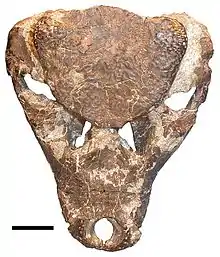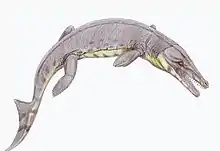Iharkutosuchus
Iharkutosuchus ("Iharkút crocodile", after where it was found) is an extinct genus of basal eusuchian crocodyliform. Its fossils have been found in the Santonian-age Upper Cretaceous Csehbánya Formation in the Bakony Mountains of western Hungary. It is based on MTM 2006.52.1, a nearly complete skull, and several other partial skulls, isolated skull bones, and numerous teeth are also known. Iharkutosuchus was a small crocodyliform (skull length 11.1 centimetres (4.4 in), estimated body length 0.8 metres (2.6 ft)). Its skull was low, and the snout was short. Iharkutosuchus is unusual in its heterodonty: some of its teeth were complex and multicusped, like mammal teeth. The structure of the skull indicates that it could grind food with a mobile lower jaw, and together with the teeth suggest a diet of fibrous plant material. The genus was described in 2007 by Attila Ősi and colleagues. The type species is I. makadii, for László Makádi.[1]
| Iharkutosuchus | |
|---|---|
 | |
| Holotype skull | |
| Scientific classification | |
| Kingdom: | Animalia |
| Phylum: | Chordata |
| Class: | Reptilia |
| Family: | †Hylaeochampsidae |
| Genus: | †Iharkutosuchus Ősi et al., 2007 |
| Type species | |
| †Iharkutosuchus makadii Ősi et al., 2007 | |
References
- Ősi, Attila; Clark, James M.; Weishampel, David B. (2007). "First report on a new eusuchian crocodyliform with multicusped teeth from the Upper Cretaceous (Santonian) of Hungary". Neues Jahrbuch für Geologie und Paläontologie, Abhandlungen. 243 (2): 169–177. doi:10.1127/0077-7749/2007/0243-0169.
- Ősi, Attila; Weishampel, David B. (2009). "Jaw mechanism and dental function in the Late Cretaceous basal eusuchian Iharkutosuchus". Journal of Morphology. 270 (8): 903–920. doi:10.1002/jmor.10726. PMID 19206154.

